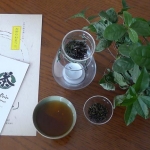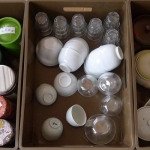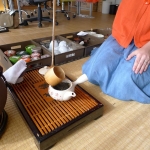Tea Ceremony
There is shelter enough if it keeps the rain off, and food enough when it staves off hunger.
We draw water, gather firewood, boil the water and make tea.
–Sen Rikyu
If asked the nature of chanoyu, say it’s the sound of wind-blown pines in a black and white painting.
–Sen Sotan
Tea should not be an exhibition of what the tea man owns. Instead the sincerity of his heart should be expressed.
–Sen Rikyu
One year, the legendary 16th century tea master Sen Rikyu planted morning glories in his Kyoto garden. The all-powerful shogun, the tyrannical Toyotomi Hideyoshi, heard of the beauty of the blooms and announced he and his retinue would travel from his castle to Rikyu’s humble tea hut to view the flowers. But when he arrives, all the morning glories have been cut down and removed, roots and all. Not a single blossom remained. Angry at the affront, he entered the tea house and found one perfect morning glory, the glorious flower shining with dew and arranged simply in a bamboo container in the small room’s alcove. As Hideyoshi began to grasp the meaning of Rikyu’s gesture, a side panel slid open and Rikyu entered to start the tea ceremony.
Some years later (1591 to be exact), the Shogun sent word to Rikyu that he was displeased with the tea master and that Rikyu was to commit ritual suicide (seppuku). Although the reason for Hideyoshi’s displeasure was never revealed, Rikyu complied. And out of respect for Rikyu, morning glories haven’t been used in the tearoom since.
Today Chanoyu is also called Chado, but in the old days it was commonly called Chanoyu. Chado literally translated is the path or way of tea, just as kendo is the way of the sword, shodo is the way of the brush, kado the way of flowers.
Over the years I have had the good fortune to participate in several tea ceremonies, both in Japan and the Bay Area of California.
When people talk about Chado or tea ceremony, they often say that understanding this art form enables a person to understand much about the Japanese culture.
On my most recent trip to Kyoto I decided to travel to the Wazuka for a tea tour offered by Kyoto Obubu tea farm on my way from Nara to Kyoto.
This small town, hidden by mountains, has over 800 years of tea history. Selected for tea production in the Kamakura period (1199-1334), Wazuka has kept the tradition of growing and making authentic tea to this day. In fact, Wazuka’s tea (which includes Matcha and Kabuse Sencha) is one of the highest regarded teas in Japan.
Nowadays, tea from Uji is famous, but, in fact, more than half of this tea is grown in Wazuka.
With more than 300 families dedicated to making the mind-clearing, heart-warming beverage, the surrounding areas of Wazuka are dotted with gorgeous tea fields. As tea is an evergreen plant, the scenery is beautiful all year round.
I spent most of the day with three young people from different parts of the world who came to participate in their intern program. They and the Obubu Family made sure that I had a wonderful and informative experience visiting the tea fields and local shrines in the surrounding mountains, having lunch in a local restaurant, and learning more about local handmade teas which they continue to make using 800 year old techniques.
Make a reservation for the tour at https://obubutea.com/
More information about various aspects of Chadoyu:
http://japanese-tea-ceremony.net/history.html
http://culture-h.jp/hatadake-katsuyo-english/TeaAndSpiritOfJapanesePeople.pdf
These are opportunities for you to experience Chado in Kyoto:
http://kouroan.com/english/index.html
https://www.tea-kyoto.com/what-you-get/garden
http://www.kpic.or.jp/english/japanese_culture/experience_classes.html
http://www.shotoku-an.org/e-top.html




